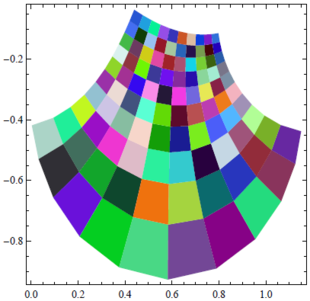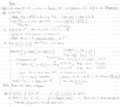12-240/Classnotes for Thursday October 4: Difference between revisions
(→Basis) |
|||
| Line 83: | Line 83: | ||
This holds is true if the field does not have characteristic 2. Can you see why? |
This holds is true if the field does not have characteristic 2. Can you see why? |
||
(a,b) = (a+b)/2 |
(a,b) = (a+b)/2 ∙ (1, 1) + (a-b)/2 ∙ (1, -1) |
||
== Lecture notes scanned by [[User:starash|starash]] == |
== Lecture notes scanned by [[User:starash|starash]] == |
||
Latest revision as of 04:46, 7 December 2012
| |||||||||||||||||||||||||||||||||||||||||||||||||||||||||
Reminders
Web Fact: No link, doesn't exist!
Life Fact: Dror doesn't do email math!
Riddle: Professor and lion in a ring with , help the professor live as long as possible.
Recap
Base - what were doing today
Linear combination (lc) - We say is a linear combination of a set if for scalars from a field .
Span - is the set of all linear combinations of the set .
Generate - We say generates a vector space is .
Pre - Basis
Linear dependence
Definition A set S ⊂ V is called linearly dependent if you can express the zero vector as a linear combination of distinct vectors from S, excluding the non-trivial linear combination where all of the scalars are 0.
Otherwise, we call S linearly independent.
Examples
1. In R^3, take S = {u1 = (1,4,7), u2 = (2,5,8), u3 = (3,6,9)}
u1 - 2u2 + u3 = 0
S is linearly dependent.
2. In R^n, take {e_i} = {0, 0, ... 1, 0, 0, 0} where 1 is in the ith position, and (ei) is a vector with n entries.
Claim: This set is linearly independent.
Proof: Suppose (∑ ai∙ei) = 0 ({ei} is linearly dependent.)
(∑ ai∙ei) = 0 ⇔ a1(1, 0, ..., 0) + ... + an(0, ..., 0, 1) = 0 ⇔ (a1, 0, ... , 0) + ... + (0, ... , an) = 0
⇒ a1 = a2 = ... = an = 0!
Comments
1. {u} is linearly independent. Proof: ⇐ If u≠0, suppose au =0 By property (a∙u = 0, a = 0 or u = 0), a = 0. Thus, {u} is linearly independent.
⇒ By definition, au = 0 for {u} only when a = 0.
2. ∅ is linearly independent.
Exercise: Prove: Theorem Suppose S1 ⊂ S2 ⊂ V.
-> If S1 is linearly dependent, then S2 is dependent.
-> If S2 is linearly independent, then S1 is linearly independent. (Hint: contrapositive)
Basis
Definition: A subset β is called a basis if (1) β generates V → span(β) = V and (2) β is linearly independent.
Examples
1. V = {0}, β = {}
2. {ei} for F^n, this is what we call the standard basis
3. B = {(1,1),(1, -1)} is a basis for R^2
4. P_n(F) β = {x^n, x^n-1, ... , x^1, x^0}
5. P(F), β = (x^0, x^1 ... and on} (Infinite basis!)
Interesting inequality
This holds is true if the field does not have characteristic 2. Can you see why?
(a,b) = (a+b)/2 ∙ (1, 1) + (a-b)/2 ∙ (1, -1)
Lecture notes scanned by starash
</math>












